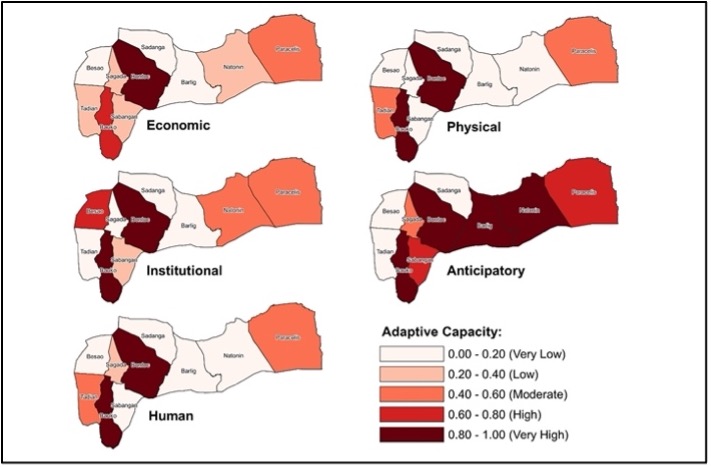VOLUME 16 NUMBER 1 (January to June 2023)

SciEnggJ. 2023 16 (1) 028-039
available online: January 31, 2023
*Corresponding author
Email Address: ri.lumbres@bsu.edu.ph
Date received: August 19, 2022
Date revised: January 16, 2023
Date accepted: January 22, 2023
DOI: https://doi.org/10.54645/2023161NGO-85
ARTICLE
Climate risk vulnerability assessment on the production of heirloom rice (Oryza sativa L.) and Arabica coffee (Coffea arabica L.) in Mountain Province, Philippines
Levi Ezekiel O. Daipan1, Roscinto Ian C. Lumbres*1,2, Myra Nieves T. Lingaling1, Lynn J. Talkasen1,3, Quinerlyn A. Godio1, and Guillermo A. Mendoza4
1Center for Geoinformatics, Benguet State University, La Trinidad, Benguet
2601, Philippines
2College of Forestry, Benguet State University, La Trinidad, Benguet
2601, Philippines
3College of Agriculture, Benguet State University, La Trinidad, Benguet
2601, Philippines
4Professor Emeritus,
Department of Natural Resources and Environmental Sciences,
University of Illinois, Urbana, Illinois, USA
2601, Philippines
2College of Forestry, Benguet State University, La Trinidad, Benguet
2601, Philippines
3College of Agriculture, Benguet State University, La Trinidad, Benguet
2601, Philippines
4Professor Emeritus,
Department of Natural Resources and Environmental Sciences,
University of Illinois, Urbana, Illinois, USA
Climate change has brought negative and adverse impacts to agricultural production in the Cordillera Administrative Region, including two of the most important agricultural crops, namely, Arabica coffee and heirloom rice. This study was conducted to assess the climate risk vulnerability on the production of these two agricultural products in the municipalities of Mountain Province, Philippines. The climate risk vulnerability was assessed based on the three general and most widely used climate impact factors as recommended by the Intergovernmental Panel on Climate Change (IPCC), namely, exposure to hazard, sensitivity, and adaptive capacity.
The results show, based on the combined indices estimated for each of the three general factors and expected changes in temperature and precipitation as projected by IPCC, that there is high climate risk vulnerability of the two crops in the municipalities particularly in areas where there is high potential exposure to hazards, low climate suitability of key crops in the future, and low adaptive capacity. Findings from the climate risk vulnerability analysis (CRVA) developed in the study demonstrate that it, as described in this paper, can serve as a meaningful reference to inform and guide decision-makers from concerned government agencies and the private sector in crafting policies and potential interventions in highly vulnerable areas whose climate risk vulnerability can be estimated and determined using CRVA. It is recommended that the CRVA described in this paper be made part of the tools and potential guides used by the Department of Agriculture to help mainstream climate change adaptation and mitigation strategies.
The results show, based on the combined indices estimated for each of the three general factors and expected changes in temperature and precipitation as projected by IPCC, that there is high climate risk vulnerability of the two crops in the municipalities particularly in areas where there is high potential exposure to hazards, low climate suitability of key crops in the future, and low adaptive capacity. Findings from the climate risk vulnerability analysis (CRVA) developed in the study demonstrate that it, as described in this paper, can serve as a meaningful reference to inform and guide decision-makers from concerned government agencies and the private sector in crafting policies and potential interventions in highly vulnerable areas whose climate risk vulnerability can be estimated and determined using CRVA. It is recommended that the CRVA described in this paper be made part of the tools and potential guides used by the Department of Agriculture to help mainstream climate change adaptation and mitigation strategies.
© 2024 SciEnggJ
Philippine-American Academy of Science and Engineering